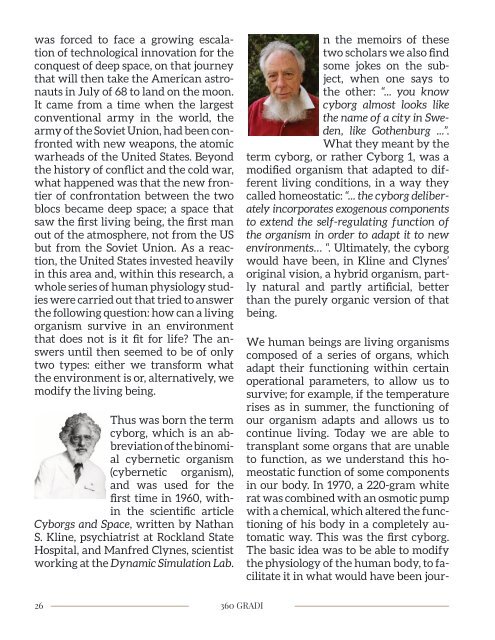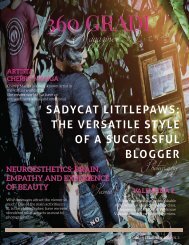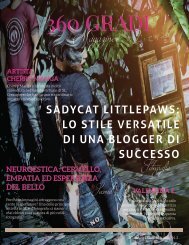360 GRADI MAGAZINE // MAY-JUNE 2021
360 GRADI Magazine is the trendy, elegant, refined, and sophisticated publishing about Second Life (the virtual world by Linden Lab). Out every two months.
360 GRADI Magazine is the trendy, elegant, refined, and sophisticated publishing about Second Life (the virtual world by Linden Lab).
Out every two months.
You also want an ePaper? Increase the reach of your titles
YUMPU automatically turns print PDFs into web optimized ePapers that Google loves.
was forced to face a growing escalation<br />
of technological innovation for the<br />
conquest of deep space, on that journey<br />
that will then take the American astronauts<br />
in July of 68 to land on the moon.<br />
It came from a time when the largest<br />
conventional army in the world, the<br />
army of the Soviet Union, had been confronted<br />
with new weapons, the atomic<br />
warheads of the United States. Beyond<br />
the history of conflict and the cold war,<br />
what happened was that the new frontier<br />
of confrontation between the two<br />
blocs became deep space; a space that<br />
saw the first living being, the first man<br />
out of the atmosphere, not from the US<br />
but from the Soviet Union. As a reaction,<br />
the United States invested heavily<br />
in this area and, within this research, a<br />
whole series of human physiology studies<br />
were carried out that tried to answer<br />
the following question: how can a living<br />
organism survive in an environment<br />
that does not is it fit for life? The answers<br />
until then seemed to be of only<br />
two types: either we transform what<br />
the environment is or, alternatively, we<br />
modify the living being.<br />
Thus was born the term<br />
cyborg, which is an abbreviation<br />
of the binomial<br />
cybernetic organism<br />
(cybernetic organism),<br />
and was used for the<br />
first time in 1960, within<br />
the scientific article<br />
Cyborgs and Space, written by Nathan<br />
S. Kline, psychiatrist at Rockland State<br />
Hospital, and Manfred Clynes, scientist<br />
working at the Dynamic Simulation Lab.<br />
n the memoirs of these<br />
two scholars we also find<br />
some jokes on the subject,<br />
when one says to<br />
the other: “... you know<br />
cyborg almost looks like<br />
the name of a city in Sweden,<br />
like Gothenburg ...”.<br />
What they meant by the<br />
term cyborg, or rather Cyborg 1, was a<br />
modified organism that adapted to different<br />
living conditions, in a way they<br />
called homeostatic: “... the cyborg deliberately<br />
incorporates exogenous components<br />
to extend the self-regulating function of<br />
the organism in order to adapt it to new<br />
environments… “. Ultimately, the cyborg<br />
would have been, in Kline and Clynes’<br />
original vision, a hybrid organism, partly<br />
natural and partly artificial, better<br />
than the purely organic version of that<br />
being.<br />
We human beings are living organisms<br />
composed of a series of organs, which<br />
adapt their functioning within certain<br />
operational parameters, to allow us to<br />
survive; for example, if the temperature<br />
rises as in summer, the functioning of<br />
our organism adapts and allows us to<br />
continue living. Today we are able to<br />
transplant some organs that are unable<br />
to function, as we understand this homeostatic<br />
function of some components<br />
in our body. In 1970, a 220-gram white<br />
rat was combined with an osmotic pump<br />
with a chemical, which altered the functioning<br />
of his body in a completely automatic<br />
way. This was the first cyborg.<br />
The basic idea was to be able to modify<br />
the physiology of the human body, to facilitate<br />
it in what would have been jour-<br />
26 <strong>360</strong> <strong>GRADI</strong> <strong>360</strong> <strong>GRADI</strong><br />
27











